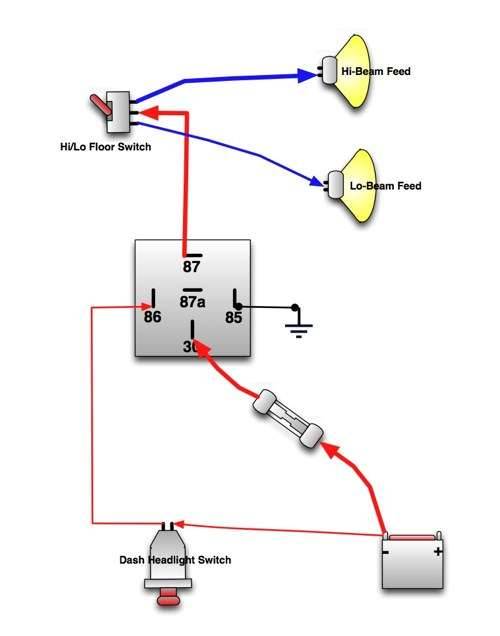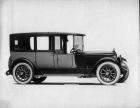|
Re: Headlight Circuit Breaker Question
|
||||
|---|---|---|---|---|
|
Home away from home
|
If I did my electrical math properly, to get the exact same protection as the original 6 volt breaker you'd have to use a 12 volt breaker with half the amp rating. Realistically, if your wiring is all in good condition you shouldn't have a problem with the 12v. A 12 volt fuse or breaker would blow or trip slower than the 6 volt of the same amperage. For instance: A 6volt 100 watt bulb uses 16.66 amps, but a 12 volt 100watt bulb would use 8.33 amps to generate the same light.
My only qualifications are industrial electric. This stuff is just on a smaller scale.
Posted on: 2009/8/18 23:03
|
|||
|
||||
|
Re: Headlight Circuit Breaker Question
|
||||
|---|---|---|---|---|
|
Webmaster
|
JD the other option is to use a relay for the headlights. Then they should be a bit brighter, and also it takes all that load of the of the switch and instrument cluster breaker. Then you can use a standard fuse holder hidden in a convenient spot.
You could do it with a 6v single relay that feeds the hi/lo beam switch, and is triggered with the headlight switch feed. Then you power the relay feed with a wire off of the starter feed (with an inline fuse holder). This basically installs in between the headlight switch and the floor hi/lo switch. So really you dont have to cut up any of the factory harness, and can be put back stock in a couple of minutes. Attach file:  (21.66 KB) (21.66 KB)
Posted on: 2009/8/18 23:31
|
|||
|
-BigKev
1954 Packard Clipper Deluxe Touring Sedan -> Registry | Project Blog 1937 Packard 115-C Convertible Coupe -> Registry | Project Blog |
||||
|
||||
|
Re: Headlight Circuit Breaker Question
|
||||
|---|---|---|---|---|
|
Forum Ambassador

|
What makes you sure the circuit breaker failed? I'd think the chances are better that you had a short in the high beam circuit.
Posted on: 2009/8/19 8:19
|
|||
|
||||
|
Re: Headlight Circuit Breaker Question
|
||||
|---|---|---|---|---|
|
Forum Ambassador
|
It's possible the breaker has weakened but also possible there is corrosion or poor contact in connectors or switches causing too much current draw. Don't believe the voltage rating for the replacement breaker is the most important factor here but more the mounting.
Cole-Hersee lists their breaker rating as 6- (thru as high as)48 volts. The voltage rating in this case usually indicates the design point where heat, breaker contact distance, distance to outer shell, or a material used in mfg could be adversely impacted if exceeded. For example, 30 amps is 30 amps be it 6 or 12v. The arc generated at 12 v when breaker opened would be a bit more substantial and hotter than one at 6v because of the extra voltage pushing it and might cause the contacts to weld or pit if too close together. Such might happen with a low rated unit used higher but one capable of working higher would be OK at either voltage because it's still 30a but would have the spacing or material for the higher capability and rating. Same holds true for household breakers rated for 120-240v--pretty much interchangeable as long as not used over the rating.
Posted on: 2009/8/19 9:19
|
|||
|
||||
|
Re: Headlight Circuit Breaker Question
|
||||
|---|---|---|---|---|
|
Home away from home
|
Thanks everyone for your input. I'll check out the dimmer/high beam switch, wiring, and connections before proceeding any further with the breaker.
Big Kev... thanks for the easy to understand schematic for changing over to a relay system. If all else fails that is a good, viable alternative solution. Will advise how it all turns out.
Posted on: 2009/8/19 9:58
|
|||
|
||||
|
Re: Headlight Circuit Breaker Question
|
||||
|---|---|---|---|---|
|
Forum Ambassador
|
Amps is Amps. The headlights are wired in a simple series circuit from the battery source (at the headlght switch, where your circuit breaker is located) and after the current is passed through the circuit breaker it goes through the switch to the dimmer switch, then to the front body harness to the headlight bulbs, which at that point are in parallel. All we have to concern ourselves with is the portion of the circuit at the headlight switch. The current is the same in a series circuit, that is why the Cole Hersee unit Howard recommends is rated from 6 to 48 volts--Amps are Amps, no matter the voltage. So the cheap O'Reilly's circuit breaker is fine. I really like Cole-Hersee goods, they are well built in my estimation, like the old days.
Did the headlights go out and stay out? or did they come back on for a moment and go back off? I thnk the problem may be elsewhere in the circuit. Our local discount auto parts store, Murray's just sold out to O'Reilly's, they are just waiting to convert over a boatload of neon signs, the employees already are wearing the green shirts.
Posted on: 2009/8/19 10:31
|
|||
|
||||
|
Re: Headlight Circuit Breaker Question
|
||||
|---|---|---|---|---|
|
Home away from home
|
jd, you may want to rethink this idea. i had two customer's cars do the same thing one convertible and one 4dr. both 49's. they both had bad DIMMER SWITCHES.
Posted on: 2009/8/20 18:59
|
|||
|
||||
|
Re: Headlight Circuit Breaker Question
|
||||
|---|---|---|---|---|
|
Home away from home

|
Quote:
The reason I ask is because I read in a thread on another forum from a guy who has electrical engineering in his background that it is ok to use a 12 volt 30amp breaker on a 6 volt system. With my electronics background I agree with the above. The overload protection provided by a circuit breaker or a fuse is there to protect the wire from becoming the fuse in the case of a short. If you overload a circuit that does not have some sort of protection the wire itself will get hot and possibly catch fire. Here we go again about 6 and 12 volts. It's the current that blows the fuse or trips the breaker. 30 amps is 30 amps no matter what the voltage is. Granted all other things being equal if you double the voltage the current will also double however What blows a fuse or a breaker is the current not the applied voltage. By the way the voltage rating on a fuse (ie. 10amp/250volts)Means that the fuse will completely open up with 250 volts across it when the 10 amps is exceeded. In other words don't use this fuse to fuse voltages exceeding 250 volts. You can use a fuse rated for 250 volts on your 6 volt light circuit with out any problem. The following quote is said very well. This is what I was trying to say. Quote: The arc generated at 12 v when breaker opened would be a bit more substantial and hotter than one at 6v because of the extra voltage pushing it and might cause the contacts to weld or pit if too close together.
Posted on: 2009/8/24 15:33
|
|||
|
||||
|
Re: Headlight Circuit Breaker Question
|
||||
|---|---|---|---|---|
|
Home away from home

|
Quote:
What makes you sure the circuit breaker failed? I'd think the chances are better that you had a short in the high beam circuit. Good Question! This has happened to me on probably 4 or 5 different cars in the past and the problem was the dimmer switch.
Posted on: 2009/8/24 15:36
|
|||
|
||||








